1996 PONTIAC GRAND-AM stop start
[x] Cancel search: stop startPage 117 of 356

I NOTICE:
If you keep driving your vehicle with this light
on, after a while, your emission controls may nmot
work as well, your fuel economy may not be as
good and your engine may not run as smoothly.
This could lead to costly repairs that may not be
covered by your warranty.
This light should come on, as a check to show you it is
working, when the ignition
is on and the engine is not
running.
If the light doesn’t come on, have it repaired.
This
light will also come on during a malfunction’ in one
of two ways:
0 Light Flashing -- A misfire condition has been
detected.
A misfire increases vehicle emissions and
may damage the emission control system on your
vehicle. Dealer or qualified service center diagnosis
and service is required.
0 Light On Steady -- An emission control system
malfunction has been detected on your vehicle.
Dealer or qualified service center diagnosis and
service may be required.
If the Light Is Flashing
The following may prevent ml
your vehicle:
0 Reduce vehicle speed.
0 Avoid hard accelerations.
0 Avoid steep uphill grades.
e serious damage to
i
If towing a trailer, reduce the amount of cargo being
hauled as-soon as it is possible.
If the light stops flashing and remains on steady, see “If
the Light Is On Steady” following.
If the light continues to flash, when it is safe to do so,
stop the vehicle. Put your vehicle in PARK (P). Turn the
key off, wait at least 10 seconds and restart the engine.
If the light remains on steady, see “If the Light Is On
Steady” following.
If the light is still flashing follow the
previous, steps, and drive the vehicle to
your dealer or
qualified service center for service.
2-61
ProCarManuals.com
Page 119 of 356
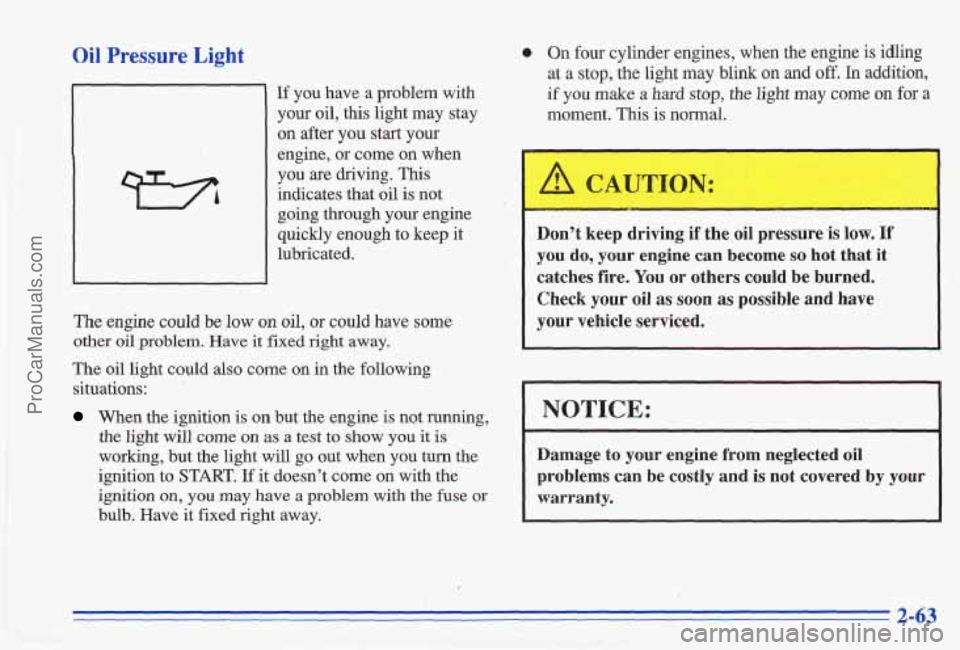
Oil Pressure Light
..
If you have a problem with your oil, this light may stay
on after you start your
engine,
or come on when
you are driving. This
indicates that oil is not
going through your engine
quickly enough to keep it
lubricated.
The engine could be low
on oil, or could have some
other oil problem. Have it fixed right away.
The oil light could also come on in the following
situations:
When the ignition is on but the engine is not running,
the light will come on as a test to show you it is
working, but the light will go out when you turn the
ignition to START. If it doesn’t come on with the
ignition
on, you may have a problem with the fuse or
bulb. Have it fixed right away.
0 On four cylinder engines, when the engine is idling
at
a stop, the light may blink on and off. In addition,
if you make a hard stop, the light may come on for a
moment. This is normal.
Don’t keep driving if the oil pressure is low.
If
you do, your engine can become so hot that it
catches fire. You or others could be burned.
Check your oil
as soon as possible and have
your vehicle serviced.
I NOTICE:
Damage to your engine from neglected oil
problems can be costly and
is not covered by your
warranty,
2-63
ProCarManuals.com
Page 141 of 356
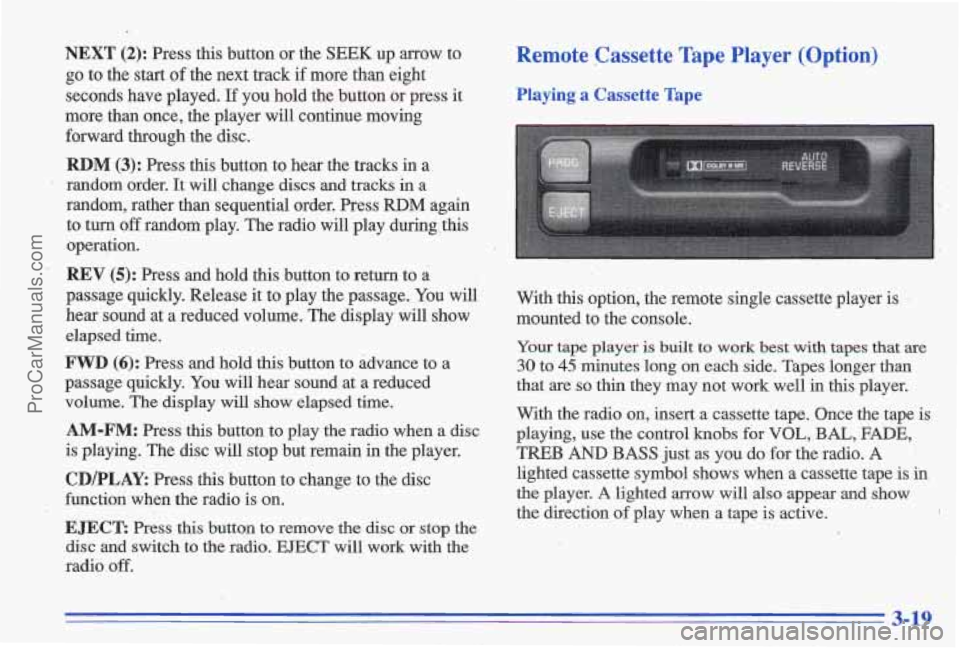
NEXT (2): Press this button or the SEEK up arrow to
go to the start of the next track if more than eight
seconds have played.
If you hold the button or press it
more than once, the player will continue moving
forward through the disc.
RDM (3): Press this button to hear the tracks in a.
. random order. It will change discs and tracks in a
random, rather than sequential order. Press RDM again to turn off random play. The radio will play during
,this
operation.
passage quickly. Release it to play the passage. You will
hear sound at
a reduced volume. The display will show
elapsed time.
FWD (6): Press and hold this button to advance to a
passage quickly. You will hear sound at a reduced
volume. The display will show elapsed time.
AM-FM: Press this button to play the radio when a disc
is playing. The disc will stop but remain
in the player.
CD/PLAY: Press this button to change to the disc
function when the radio is on.
EJECT Press this button to remove the disc or stop the
disc and switch to the radio. EJECT will work with the
radio
off.
~ REV (5): Press and hold this button to return to a .. .- 1.
.. - , . : .... .... .... .: I . . ,. ' ' ..... ... . , ~ .... ... .. ... , z . : ,, i ,*... : ~ ': .. .. I
Remote Cassette Tape
Playing a Cassette Tape
Player (Option)
Your tape player is built to work best with tapes that are
30 to 45 minutes long on each side. Tapes longer than
that are
so thin they may not work well in this player.
With the radio on, insert a cassette tape. Once the tape is
playing, use the control knobs for
VOL, BAL, FADE,
TREB AND BASS just as you do for the radio. A
lighted cassette symbol shows when a cassette tape is in
the player. A lighted arrow will also appear and show
the direction of play when a- tape is active.
. ~
,'
3-19
ProCarManuals.com
Page 154 of 356
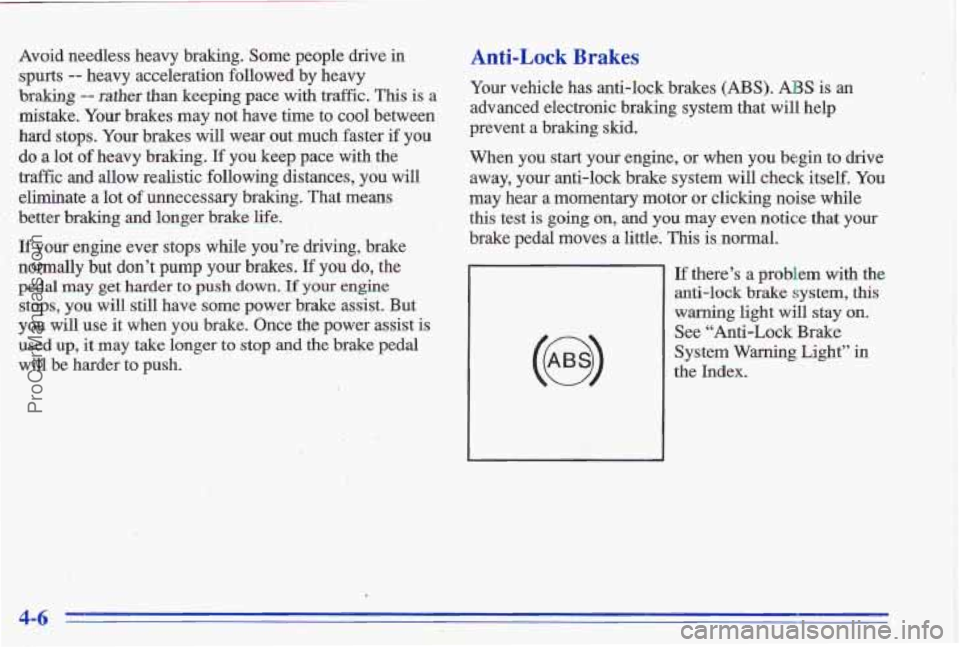
Avoid needless heavy braking. Some people drive in
spurts -- heavy acceleration followed by heavy
braking -- rather than keeping pace with traffic. This is a
mistake. Your brakes may not have time to cool between
hard stops.
Your brakes will wear out much faster if you
do a lot of heavy braking. If you keep pace with the
traffic
and allow realistic following distances, you will
eliminate a lot of unnecessary braking. That means
better braking and longer brake life.
If your engine ever stops while you’re driving, brake
normally
hut don’t pump your brakes. If you do, the
pedal
may get harder to push down. If your engine
stops, you will still have some power brake assist. But
you
will use it when you brake. Once the power assist is
used up, it m’ay take longer to stop and the brake pedal
will be harder to push.
5: , ‘
AntbLsck Brakes
Your vehicle has anti-lock brakes (ABS). ABS is an
advanced electronic braking system that will help
prevent a braking
skid.
When you start your engine, or when you begin to drive
away,
your anti-lock brake system will check itself. You
may hear a momentary motor or clicking noise while
this test is going
on, and you may even notice that your
brake pedal moves
a little. This is- normal.
(e)
If there’s a problem with the
anti-lock brake system,
this
warning light will stay on.’
See “Anti-Lock Brake
System Warning Light”
in
the Index.
4-6
ProCarManuals.com
Page 161 of 356
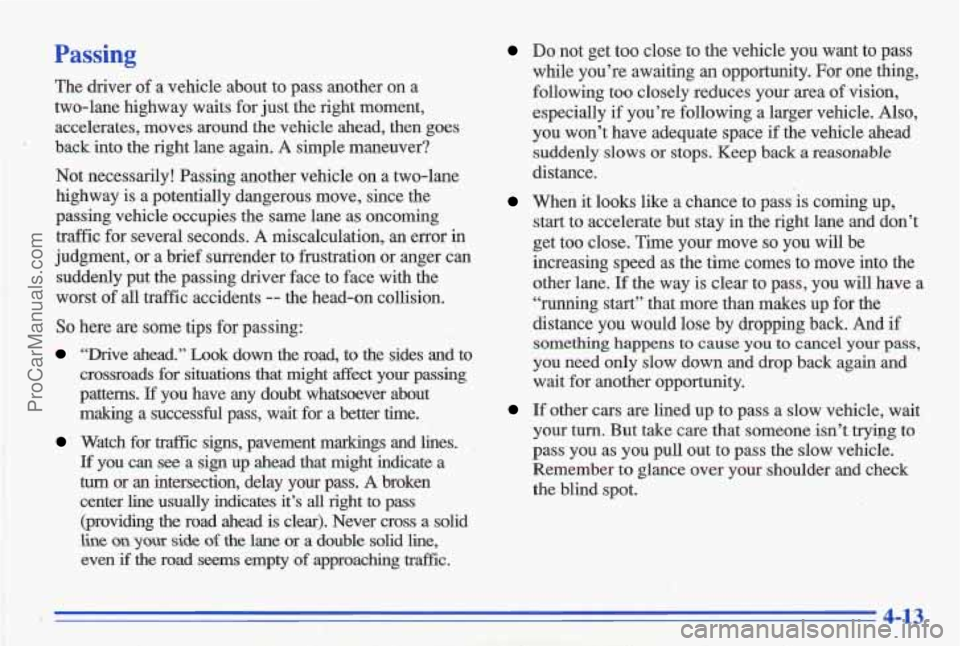
Passing
The driver of a vehicle about to pass another on a
two-lane highway waits for just the right moment,
accelerates, moves around thle vehicle ahead, then goes
” back into the right lane again. A simple maneuver?
Not necessarily! Passing another vehicle on a two-lane
highway is a potentially dangerous move, since the
passing vehicle occupies the same lane a5 oncoming
traffic for several seconds.
A miscalculation, an error in
judgment, or
a brief surrender to frustration or anger can
suddenly put the passing driver face to face with the
worst of all traffic accidents
-- the head-on collision.
So here are some tips for passing:
“Drive ahead.” Look down the road, to the sides and to
crossroads for situations that might affect your passing
patterns.
If you have any doubt whatsoever about
making .a successful pass, wait for a better time.
Watch for traffic signs, pavement markings and lines.
Lf you can see a sign up ahead that might indicate a
turn or an intersection, delay your pass. A broken
center line usually indicates it’s
all right to pass
(providing
the road ahead is clear). Never cross a solid
line on yous side of the lane or a double solid line,
even if the road seems empty of approaching traffic.
i( . . ’.-, . .‘ d“. . .. . * ,) .: ’ ;
Do not get too close to the vehicle you want to pass
while you’re awaiting
an opportunity. For one thing,
following too closely reduces your area of vision,
especially
if you’re following a larger vehicle. Also,
you won’t have adequate space
if the vehicle ahead
suddenly slows or stops. Keep back a reasonable
distance.
When it looks like a chance to pass is coming up,
start to accelerate but stay in the right lane and don’t
get too close. Time you move
so you will be
increasing speed as the
time comes to move into the
other lane.
If the way is clear to pass, you will have a
“running start” that more than makes up for the
distance
you would lose by dropping back. And if
something happens to cause you to cancel your pass,
you need only slow down and drop back again and
wait for another opportunity.
If other cars are lined up to pass a slow vehicle, wait
your turn. But take care that someone isn’t tryigg to
pass you as you pull out to pass the slow vehicle.
Remember to glance over your shoulder and check
the blind spot.
4-13
ProCarManuals.com
Page 163 of 356
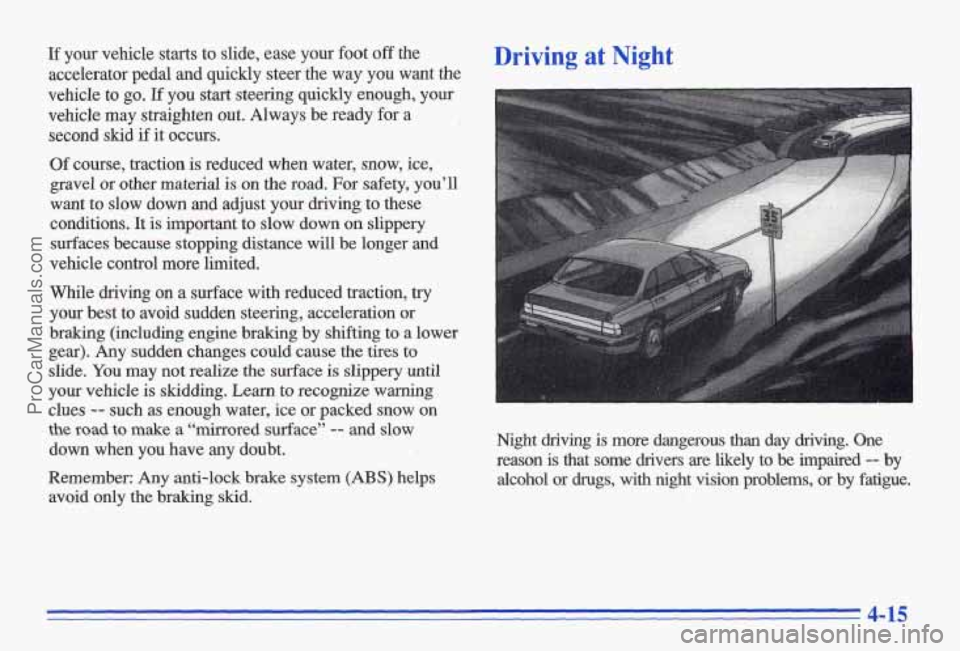
If your vehicle starts to slide, ease your foot off the
accelerator pedal and quickly steer the way you want the
vehicle to
go. If you start steering quickly enough, your
vehicle may straighten out. Always be ready for a
second skid
if it occurs.
Driving at Night
Of course, traction is reduced when water, snow, ice,
gravel or other material is on the road, For safety, you’ll
want
to slow down and adjust your driving to these
conditions. It is important to slow down
on slippery
surfaces because stopping distance will be longer and
vehicle control more limited.
While driving on a surface with reduced traction, try
your best to avoid sudden steering, acceleration or
braking (including engine braking by shifting to
a lower
gear). Any sudden changes could cause
the tires to
slide. You may not realize the surface is slippery until
your vehicle is skidding. Learn to recognize warning
clues
-- such as enough water, ice or packed snow on
the road to make a “mirrored surface” -- and slow
down when you have any doubt.
Remember: Any anti-lock brake system
(ABS) helps alcohol or drugs, with night vision problems, or by fatigue.
avoid only the braking skid. Night driving
is more dangerous than day driving. One
reason
is that some drivers are likely to be impaired -- by
4-15
ProCarManuals.com
Page 165 of 356
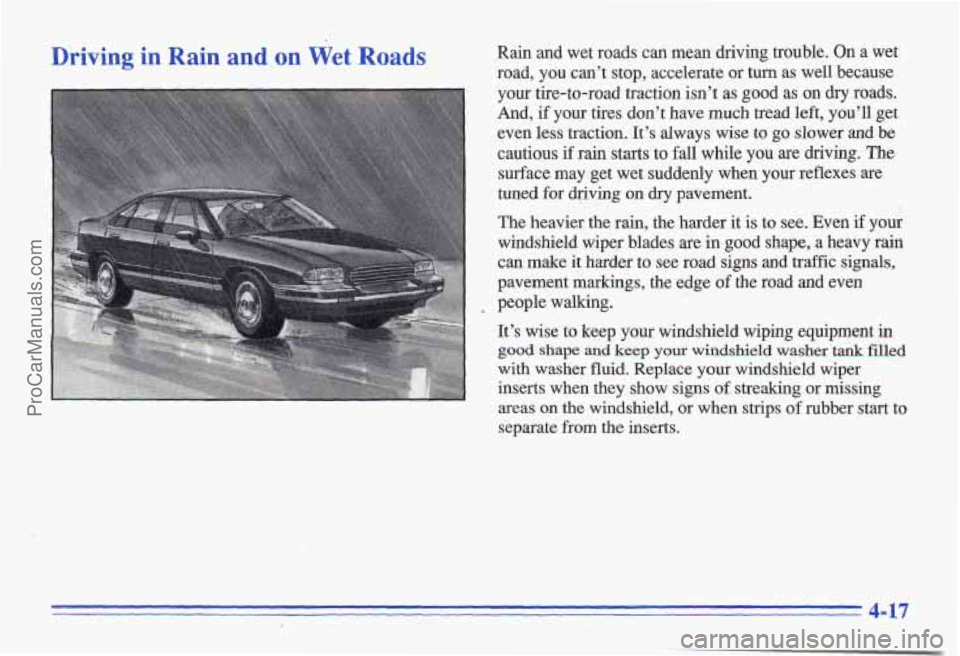
Driving in Rain and on Wet Roads Rain and wet roads can mean driving trouble. On a wet
road, you can't stop, accelerate or turn as well because
your tire-to-road traction isn't as good
as on dry roads.
And, if your tires don't have much tread left, you'll get
even less traction. It's always wise to go slower
and be
cautious
if rain starts to fall while you are driving. The
surface may get wet suddenly when your reflexes are
tuned for driving on dry pavement.
The heavier the rain, the harder it
is to see. Even if your
windshield wiper blades are in good shape,
a heavy rain
can make
it harder to see road signs and traffic signals,
pavement markings, the edge of the road and even
people walking.
It's wise to keep your windshield wiping equipment in
good shape and keep your windshield washer tank filled
with washer fluid, Replace your windshield wiper
inserts when they show signs
of. streaking or missing
areas on the windshield, or when strips of rubber start to
separate from the inserts.
' ' j ; ' '1:' ';
ProCarManuals.com
Page 187 of 356
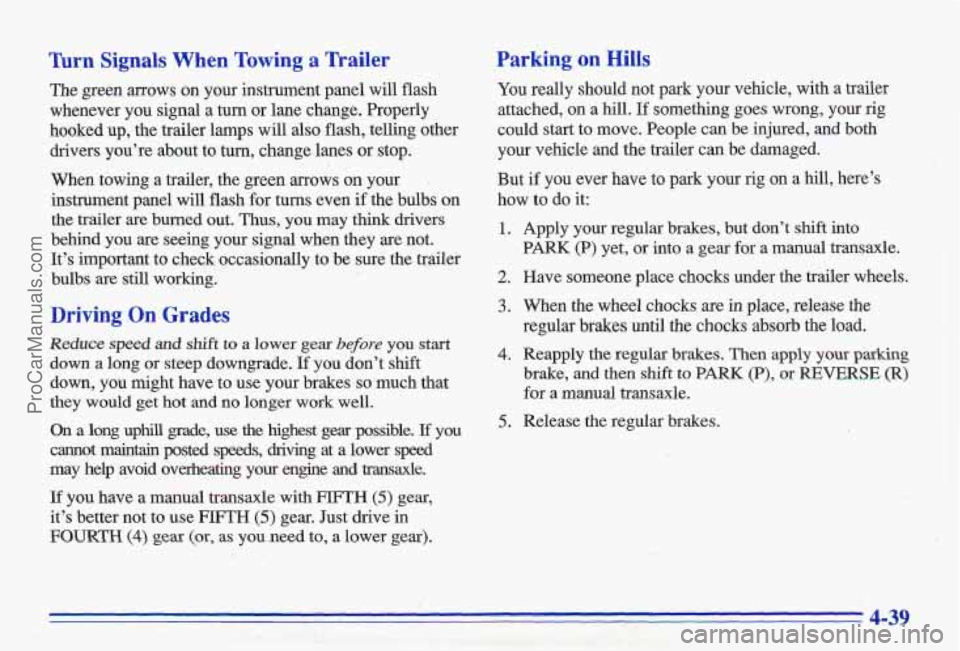
Turn Signals When Towing a Trailer
The green arrows on your instrument panel will flash
whenever you signal a turn or lane change. Properly
hooked up, the trailer lamps
will also flash, telling other
drivers you’re about to
turn, change lanes or stop.
When towing a trailer, the green arrows
on your ’.
instrument panel will flash for turns even if the bulbs on
the trailer are burned out. Thus, you may think drivers
behind you are seeing your signal when they are not.
It’s important to check occasionally to be sure the trailer
bulbs are still working.
Driving On Grades
Reduce speed and shift to a lower gear before you start
down a long or steep downgrade. If you don’t shift
down, you might have to use your brakes
so much that
they would
get hot and no longer work well.
On a long uphill grade, use the highest gear possible. If you
cannot maintain posted speeds, driving at a lower speed
may help avoid overheating your engine and bxmsaxle.
If you have a manual transaxle with FWTH (5) gear,
it’s better not to use
FIFTH (5) gear. Just drive in
FOURTH (4) gear (or- as vou need to, a lower gear).
Parking on Hills
You really should not park your vehicle, with a trailer
attached, on a
hill. If something goes wrong, your rig
could start to move. People can be injured, and both
your vehicle and the trailer can be damaged.
But if you ever have to park your rig on a hill, here’s
how to
do it:
1.
2.
3.
4.
5.
Apply your regular brakes, but don’t shift into
PARK (P) yet, or into a gear for a manual transaxle.
Have someone place chocks under the trailer wheels. When the wheel chocks are in place, release the
regular brakes until the chocks absorb
the load.
Reapply the regular brakes. Then apply your
parking
brake, and then shift to PARK (P), or REVERSE (R)
for a manual transaxle.
Release the regular brakes.
4-39
ProCarManuals.com